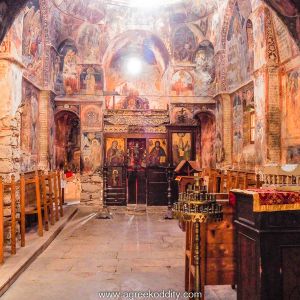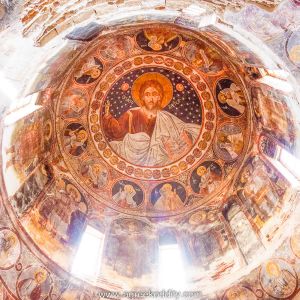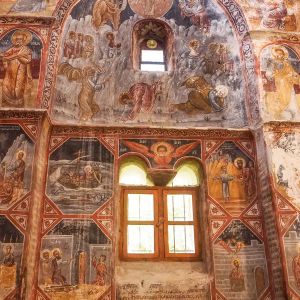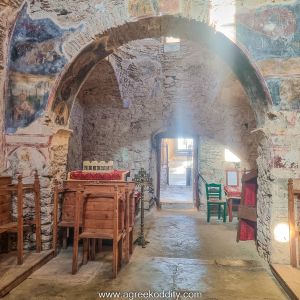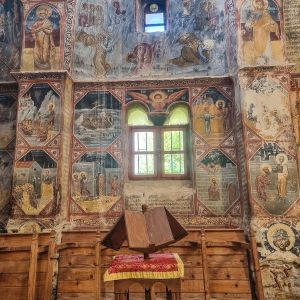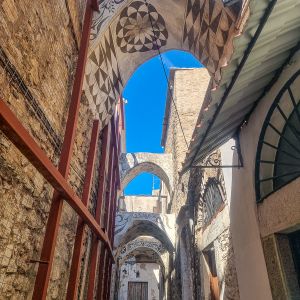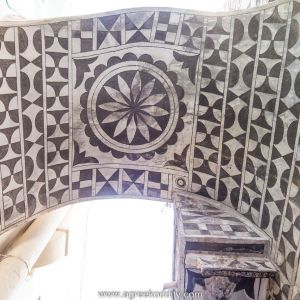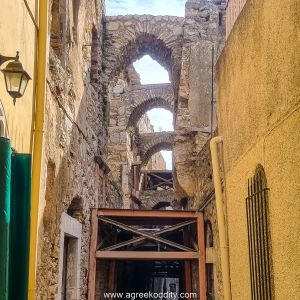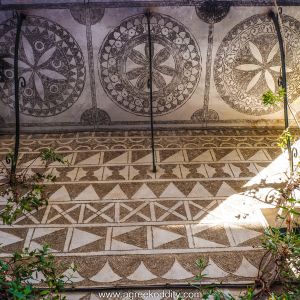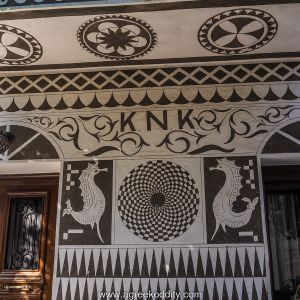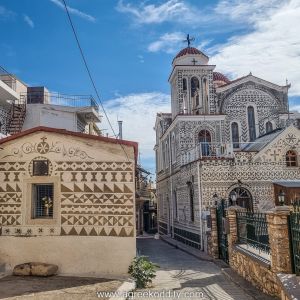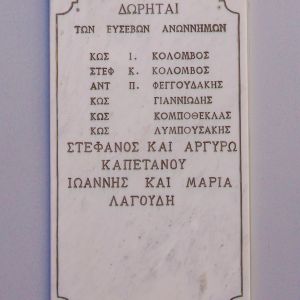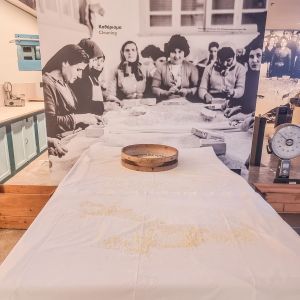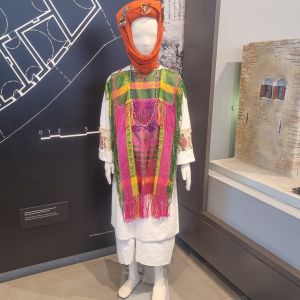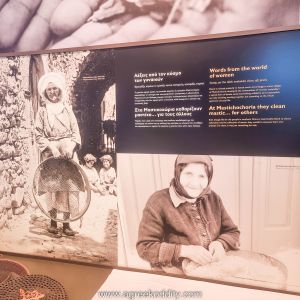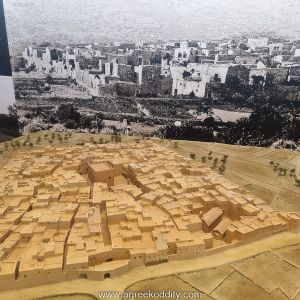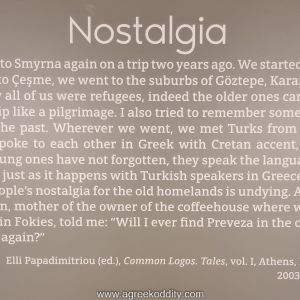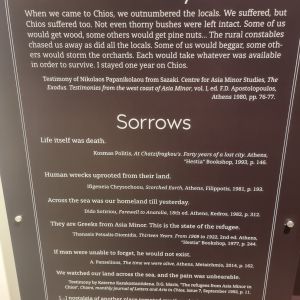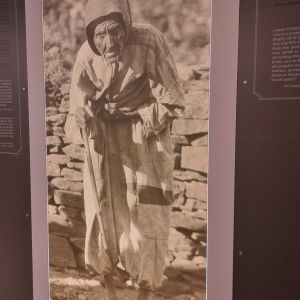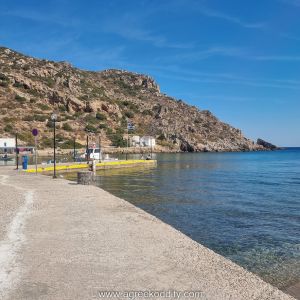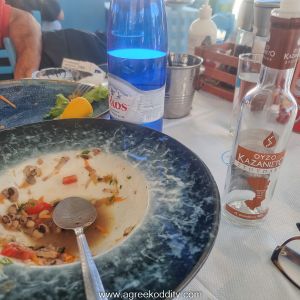Pyrgi Wanderings and a Surprise Trip!
It’s Sunday and the bells of the Church of the Assumption of the Theotokos weave their way through my bedroom window. The familiar three times clang of the call to service, serves as a most unique alarm clock! I like it. It brings a smile to my face.
I’d slept well in my medieval bed in the medieval house – thankfully not a medieval mattress! The neighbours across the way are already in deep and loud conversation, so much so, they could be in the bedroom with me! I get ready and make my way out, down the narrow street into the main square. The cafe’s are already open and groups of well dressed elderly women make their way out of church, chatting and laughing together.
I head out of the square before the coach trips arrive. To be honest, even when they are here the groups only seem to be small. Maybe because it is now slightly out of season – though Chios does brand itself as the island of all seasons. I firstly go to look at the the Church of Agioi Apostoloi, the beautiful Byzantine church said to have been built between the 14th and 15th century. The dome is based on the Katholicon of Nea Moni, the monastery that sits in the centre of Chios. The wall paintings were done by Cretan artist Antonios Kynegos 1665. Although there are elements of the Cretan folk style of art, there also modern influences in his work. The church has survived attacks by the Ottomans along with earthquakes and it is still fully intact.
The place is beautiful and I have it all to myself!
Further down that same side street I pass another small church on my right. On the left is a really good example of the small bridges that connect the houses – a way to cross from house to house in case of an attack by pirates. I imagine this as a type of medieval Parkour!
The geometric designs can be found everywhere including the underside of balconies. You’ll also see strings of cherry tomatoes hanging out to dry from balconies and on the outside of the house.
Although Pyrgi is sometimes called the painted village, the process of creating the Xysta is not by using grey and white paint. It is not made by the use of stencils. The houses are rendered with a plaster using a particular mix of sand to give it a rough texture. Once dry, the render is covered in a lime whitewash and then section by section using basic tools such as a scraper and a compass, the surface of the whitewash is scratched off revealing the grey render. Considering the complexity of the designs and the position and location of the areas receiving the treatment, that’s pretty amazing. Gus tells me that there are only a few people left who have this trade. Let’s hope that there will be another generation of people to continue this art.
I find myself outside another church which Google translates an inscription as the Church of the Assumption of the Virgin Pyrgi. What’s interesting is another marble stone with an inscription where I can make out the names Kolombos. I remember Gus from the taverna telling me about the House of Christopher Coloumbus where he is said to have lived before departing for the America’s. Some of his descendants are still present in the village today. (so I read). This is where I go next.
It is an unassuming house and if you didn’t know, you may miss it. It is identified by the crest of Colombus and is located just as you exit the main square on the left hand side.
The alleyways go on forever. And this is part of the fun – just following whichever alleyway you want, not sure of where it will bring you out. And this is how I spend the morning. If I’d have come here as part of a day trip I’d have been under pressure trying to see everything within a limited amount of time, and that I think would have taken the enjoyment out of this experience.
A little later I return to the Pounti to pick up another battery for my camera. As I get ready to head out for another exploration of the alleyways, the head of Mr Costa pops up outside my door window. “Bonjour” he calls “Comment ca va?” “Ca va bien merci Monsieur Costa” I reply.
He then returns to his Grench – a mixture of Greek and French where I know that he’s asking me a question but I really don’t know what. After a bit of tooing and frooing in a combination of three languages I resort to Google Translate. Anyway, eventually I ascertain that he is asking me what plans I have for the day. Again using Google Translate I tell him that I am just exploring the village. I don’t think that this was a satisfactory answer and Mr Costa has other ideas!
I know he’s talking about his car and then he beckons to me and says “Pame!” This I understand. I’ve really no idea what’s happening but I’ll just “Pame” and see where it leads.
Mr Costa’s car is parked on the outside of the fortification – obviously the streets of Pyrgi weren’t designed for car use. He has an SUV that has had a few scrapes in it’s day but something that will cope with the mountain passes on the island.
Mr Costa drives us out of the village and at one point takes a narrow lane that looks way too small for the vehicle. He knows what he’s doing – even though I have absolutely no idea where we are going! After a little while he points up the hill and then all becomes clear. He’s taking me to the Mastic Museum! I was going to go here anyway. I know that it’s in walking distance from the village but didn’t realise how high up it was. It surely would have been a bit of a trek.
The museum is set amongst the mastic plantations and is built sympathetically within the landscape, the building itself is eco-friendly. At the museum, Mr Costa walks us to the ticket kiosk. I go to get out my purse to pay but he gesticulates to me with an up and down movement of his hand telling me to stay exactly as I was! I obediently comply!
Mr Costa leads the way into the main exhibition hall which is a pretty impressive building – very modern with well laid out exhibits. We spend an hour or so going around the exhibits, he reading the Greek information and me reading the English. After reading each section we’d turn to each other nodding our heads in acknowledgement and at last on a parallel wavelength. The main exhibition hall explains the process of growing, harvesting and the processing of the mastic resin and I can honestly say that I had no idea that it was so labour intensive. Although parts of the industry has been mechanised, many families still farm and process the mastic in the traditional way.
The museum is more than an exhibition outlining the history of the mastic industry. It also talks about the historical context of how various occupations of Chios from the Genoese to the Ottomans, exploited this valuable asset to their own advantage (and wealth). A temporary exhibition hall has a special exhibition entitled “Across the Sea” remembering the centennial of the Asia Minor Catastrophe. There are striking images accompanied by iconic works of modern Greek literature and personal testimonies of people that lived through these horrific events. A very moving exhibition from a not too distant past.
I can’t recommend this museum enough. To understand the mastic industry I think is to understand the people of Chios.
I could have spent much longer in this museum but Mr Costa I’m sure has been here many times before and I think has somewhere else to go. Back into the car we go and we don’t seem to be heading back to Pyrgi. After making a bit of small talk along the way he says “Mavra Volia.” This is another place that I’d wanted to visit but wasn’t sure if I’d be able to make it using public transport. This is fantastic! Mr Costa parks up and we walk to the beach which is famous for its black lava rocks. A very unique beach. We don’t stay for long but we drive a short distance away to Emporios beach. Once parked up Mr Costa asks me “Birra or Ouzo”. I don’t usually drink during the day because it knocks me out, but I throw caution to the wind and say “Ouzo!”
On the harbour front there is a taverna called Karagiorgis Emporios and this is where we sit. A lady brings us a menu. Mr Costa orders a few things from the menu to accompany the ouzo – what I don’t know. The ouzo is brought to the table along with a plate or squid, a plate of fried fish and a bowl of salad made from beans and tomatoes. Mr Costa tells me that the beans are from Pyrgi.
This looks fantastic but I’m a bit of a funny person when it comes to sea food and both squid and fish complete with head isn’t something that I’d eat out of choice. However, I absolutely wouldn’t offend my very kind host. I chew my way through the squid. And I chew and chew and chew and take a swig of ouzo to wash it down! The flavour is nice but for me, it’s a texture thing. For the life of me I don’t understand why people love squid and octopus so much. The salad is very nice and I pile this onto my plate just putting off the inevitable – the fish. There comes a point where I can delay no longer and take one of the fish and put it on my plate. It’s just the size where you can eat it whole but you also have to navigate the bones of which there are quite a few. I don’t want to end up doing a Queen Mother so try and pick the flesh off the best I can – without looking like a fussy eater. More ouzo is thrown back.
That just about knocks me out of the day. We drive back to Pyrgi where I collapse in my medieval bedroom until the effects of the ouzo has worn off. The one thing that I do that evening apart from a little more wandering around the village is go to see Manos to ask if he has any mastic oil that was recommended to me by Gus. Unfortunately he doesn’t have any but he tells me his brother Vassilis has a shop in Chios Town and he will have some in. What a day! What a great day! What a lovely kind host!



